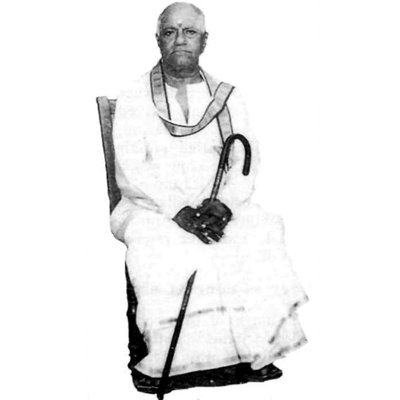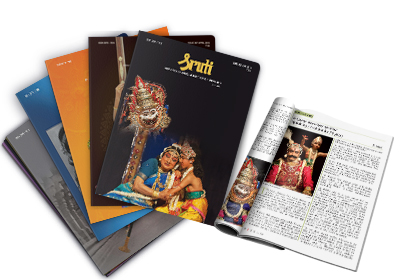
It was the late nineteen thirties and I must have been seven or eight at that time. Two elder sisters and I were living in an erstwhile royal hunting lodge near Ravannadoravalasa, a tribal hamlet. Curtailed by royal protocol, our only entertainment was a cosmopolitan stack of records and a wind-up gramophone, a part of my mother's dower.
That was when I developed an ear for Carnatic music, through Mathuranagarilo sung by Chittoor Subramania Pillai. Possibly the multi-coloured Broadcast label on the 78 rpm disc attracted me to it initially. In time I was drawn to Rama neepai tanaku on the other side too. Thus it happened that I could recognise Anandabhairavi and Kedaram before I could recognise any other raga.
Our liking for the Anandabhairavi song was reinforced by two other factors. One, it was about Krishna. And two, it was danced on stage (in the mid-forties) by the only dancer we knew and were fond of, namely Baby Kamala.
It was in the fifties, when he was in Tirupati, that I met Chittoor in person. I was delighted. And he was impressed with me, not by my musical knowledge—it was non-existent—but by the sheer love I had for his other Krishna-based songs as well, namely, Mavalla kadamma and Kulamulona. Once when we presented Mathura nagarilo for the Sakshatkara Vaibhavam festival (ashadha suddha saptami) at Srinivasa Mangapuram near Tirupati, as our nritya nivedana (dance offering) he was quite elated but could not make it to the temple.
A lot later, I prevailed upon Kalanidhi Narayanan, my guru in abhinaya, to present one of these songs on stage and she chose Mavalla kadamma.
My camaraderie with Chittoor gave me a lot of insight into his singing and into the writing of these three songs. I was quite impertinent in my crossexamination, not out of any disrespect but out of zealous curiosity. Who wrote these songs? When? When were they recorded? And most important—a fact that is unrecorded by all the learned discourses about him in the recent meets at Hyderabad and Timpati—why did he put in a forcefully articulated 'ha' at the beginning of every song, 'Rhama neepai tanaku' and 'Mhavalla kadamma' most conspicuously?
At this last question, he laughed and explained patiently, his patience and indulgence born out of my obvious love for these songs. Mine was a question, not a criticism. "I have a voice that tends to be phlegmatic (literally). If I cleared my voice into the mike every time I started a song, it would disturb the audience. So I simultaneously start the song and clear my throat. That's where the 'ha' comes from. It is not a vain [he used the word vveen' in Tamil] mannerism but something dictated by necessity."
Conditioned by this, if anybody sings Rama neepai without the 'ha', I find it timid. When I was requested by Kalanidhi Narayanan to coach her favourite accompanying vocalist, the late and long-suffering (with me) Vijayalakshmi, in the correct Telugu diction of Mavalla kadamma, I made her put the 'ha' in and, when Kalanidhi objected to this, I explained that the 'ha' would help a dancer to project, with a vigorous shake of the head properly timed to 'Mhavall', the heroine's exasperation with Krishna, and her vehement expression to Yasoda about his love-deeds, sorry, misdeeds.
Though Columbia brought out as Gopika Geetham the two songs Mavalla and Kulamulona in the early forties, when Mathuranagarilo was at the top of the charts in dance programmes, I don't recall anyone attempting the other two in dance. But all three are extremely abhinaya-oriented and the way Chittoor sang them, laya-turned too, giving room for abhinaya-dictated nritta. This can be particularly noticed in the violin-mridanga interlude after 'mapati velaku' in Mathuranagarilo. I know it is the fashion of the day for the elite (I'd say effete) incognoscenti to give singers like Chittoor and Chembai (another childhood favourite of mine whose stellar rating continues unabated in my reckoning) only a reluctant nod. For those who grew up on their robust voice, spitfire swarasinging, and correct renditions of proper pathantara-s, it is difficult to warm up to others who are totally dependent upon their glibly streamlined vocalising. [As an aside, let me add that in the recordings I possess and have heard, neither of them insulted composers by starting their songs with anything but the pallavi].
Chittoor told me that he wrote Mathuranagarilo and that he re-wrote Kulamulona and Mavalla kadamma out of an itinerant singer's repertoire. T.S. Parthasarathy told me, however, that Chittoor's Telugu was not good enough to have composed a sophisticated piece like Ma thuran agarilo. Let me be modest for once and say this: I know my Telugu and while Chittoor's was not impeccable, I do believe that he wrote the song. Venugopal (once of Spencer's) knows even less but his Telugu compositions are respected by the best of Carnatic musicians. Anyway, Mathuranagarilo is but a variation of a Sarangapani padam, Bottugattina vadu in Anandabhairavi, (listed as Ottubetra in the 78 rpm disc by Veena Dhanam), a change-over from a padam format to a javali structure very much like Mogudochi and Kshetrayya's Athavaruriki, both in Sahana.
Chittoor was not the kind of a person who would claim another's work to be his own.
Anyway, I give the texts of these songs and their free translations, in order to help dancers wishing to present them on stage. (See box). The translations may not satisfy the scholars but surely Chittoor would be pleased by my pooja.
There are a few minor variations in the text of Mathuranagarilo currently used but I take the version recorded by Chittoor as the correct one. Incidentally, the final line is not on the Chittoor's recording of the song; it was given to me by T. Lokanadha Sarma.
Chittoor did not record Amma Yasoda but he did record Mavalla kadamma and Kulamulona in Misra Mand (Adi) and Sindhubhairavi (Roopakam) respectively. They are as good as the best about Krishna's pranks, as far as the matter is concerned. The language, not superb perhaps, is simple, grammatical.
Chittoor's daughter Revathy Rathnaswamy, a musician-teacher herself, and Lokanadha Sarma claim two different raga-s for the song Amma Yasoda, namely, Sankarabharanam and Misra Mand. Some others claim it is in Misra Chenchuritti. I leave that knot for musicalexanders.
I remember Rajkumari Indira Devi of Bobbili and her guru J. Subbulakshmi play it as a veena duet on AIR in the late forties. She did not use Chittoor's sangatis or his fast pace; as a matter of fact, she says that she didn't much care for his voice. But the song, that's a different and delightful pot of 'challa'!
Mathuranagarilo has been danced on stage innumerable times by exponents of the Vazhuvoor bani. Both the Telugu films on Tyagaraja (Tyagayya, 1946, 1981) featured it and the first use led one Andhra scholar, Aripirala Satyanarayanamurthy (in his Sangeeta Kala Pradarsini) to claim that it was the composition of one Tribhuvanam Swaminadha Iyer, which was the character's name in the film! That's how strongly films influence classical musicians despite their denials and protests and touch-me-not Bostonian attitude.


